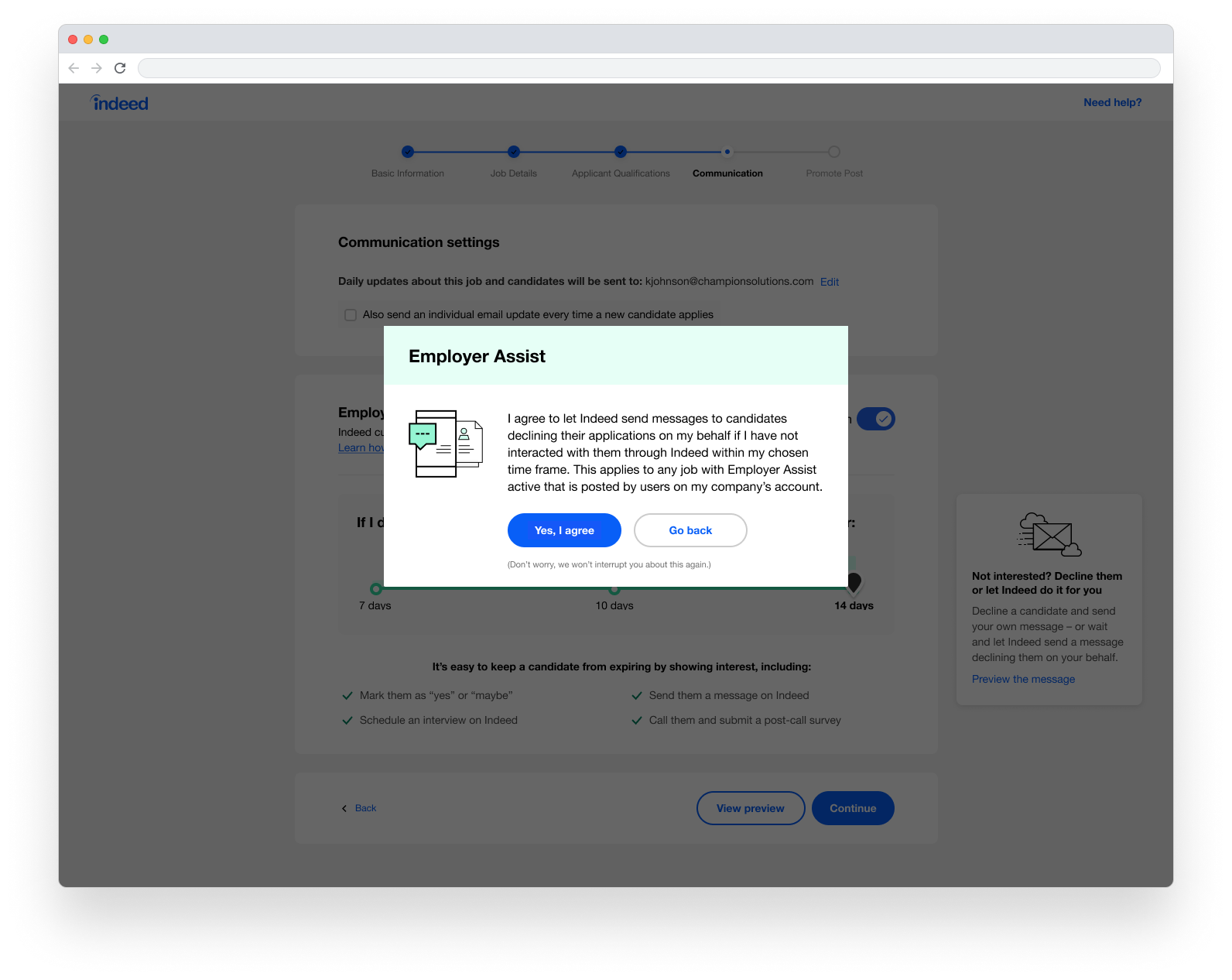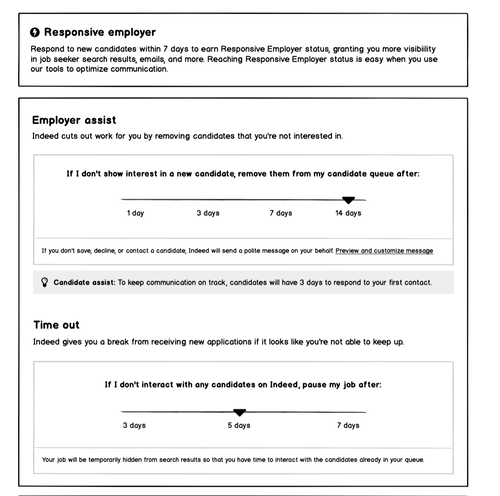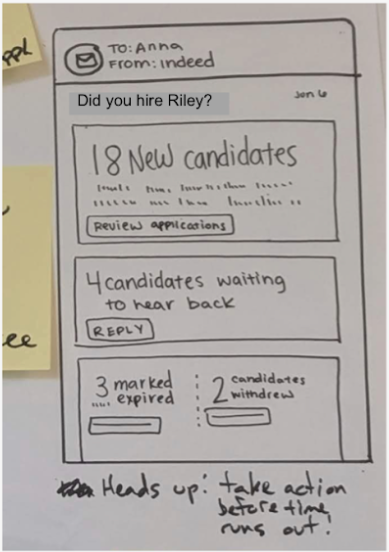Employer Assist / Indeed Assist
CONCEPT / UX / UI / Copywriting
Job applications and messages often seem to fall into a “black hole” – users simply never get a response – and solving this “professional ghosting” problem is one of Indeed’s highest priorities. My team led the charge and the impact has been substantial.
User stories
As an employer, I want to receive timely replies from job seekers so that I can quickly find and hire the best candidates quickly.
As a job seeker, I want to be informed of the status of my job application and receive replies to my messages so that I can know which jobs to focus on and find a promising new job as soon as possible.
My role
I created the concept during a workshop and then designed, tested, and iterated on prototypes with another designer and a UX researcher during the initial design sprint. When the sprint concluded, I continued as the sole UX and visual designer while the feature was being developed. I was a hands-on partner in every research session, design review, legal review, and team presentation.

The challenge
The black hole problem was identified by senior leadership as one of the top priorities for the company in 2019. Getting no response from employers was the biggest detractor for job seekers using Indeed. Likewise, getting no response from applicants was a top complaint for employers.
Employers told us that they were often too busy to respond to every application or that they felt uncomfortable sending a rejection message. So they just… did nothing.
Meanwhile, job seekers told us that they often didn’t respond if they had a more promising opportunity at another company. And again, it was uncomfortable sending a message saying they were no longer interested in a job.
The solution
Employer Assist for employers:
When posting a new job, make an agreement between the user and Indeed that they will respond to new applications within a time frame of their choosing. If they do not take action on a new application, Indeed will assume they are not interested in the candidate, automatically decline them, and remove them from the employer’s list of active candidates.
Candidate Assist for job seekers:
When an employer contacts them, let the candidate know that they are expected to respond within a certain time frame. If they do not respond, Indeed will assume they are not interested and automatically withdraw their application.
How we did it
Historically, small tweaks to Indeed’s communication tools had been ineffective, so a larger effort was in order. To that end, a workshop was organized to examine the problem, talk to employers and job seekers in person, and understand their current experiences. Having one team work on a solution for both employers and job seekers was outside of Indeed’s siloed structure. But communication is a two-sided problem, and we needed to solve it as one challenge.
› A solid idea from the start
The initial idea for Employer Assist came to me during the workshop: an agreement with the employer creates a shared understanding of marketplace expectations and gives the employer a sense of control over their workflow.
› address both sides of the equation
In the long-term vision of Indeed Assist, both employers and candidates have an agreement with Indeed that they will be active participants in the hiring process, and Indeed will support them in staying active.
› Research and iterate at high speed
We combined design and research early on, starting with a 3-day workshop followed immediately by a 4-week design sprint. Guided by our talented researcher, my fellow designer and I put low-fidelity iterations of the feature in front of 28 real people.
› Define a v1, build it, and measure it
Collaborating with product managers and engineering partners, we defined the scope of our initial rollout. Our focus would be on the Employer Assist aspect of the solution, followed by the remaining pieces if it showed success. I brought the designs to full fidelity, partnering with content strategy and research to make refinements and an amazing engineering team to bring it to life.
› High risk, high value
As you can imagine, rejecting and withdrawing candidates is a risky endeavor – we’re making choices about people’s livelihoods, and we can’t get it wrong. Understandably, our legal team had Employer Assist under a microscope every step of the way. To mitigate risk and misunderstandings, we had planned extensive messaging both on the site and via email to keep users aware of their timelines and imminent actions.
The outcome
Employer Assist is a success
› Our goal was to see a 10% increase in employers responding to job seekers
› The number of new employers responding to job seekers improved by 55%
› The number of existing employers responding to job seekers improved by 25%
› We see statistically significant improvement in positive responses and hiring outcomes
› No negative effects to metrics or customer service feedback
› Nearly 100k employers have opted into the feature
› Employer Assist is currently being ramped up to 100% of users in the US and will soon be available to all users worldwide
› Employer Assist continues to be refined and efforts to build Candidate Assist are getting underway












